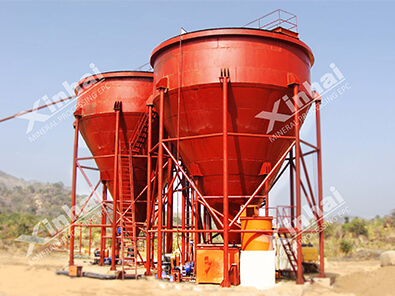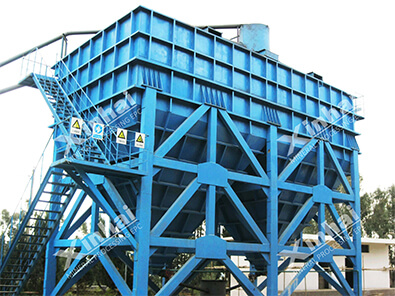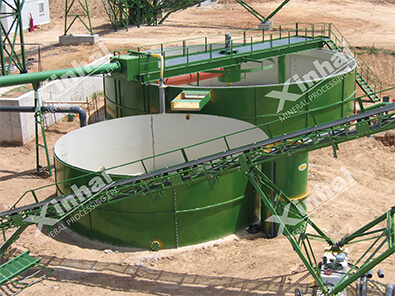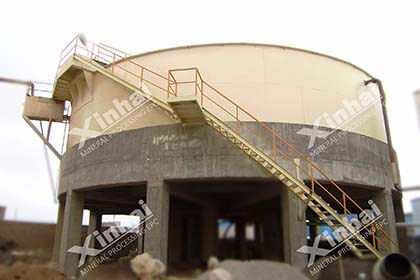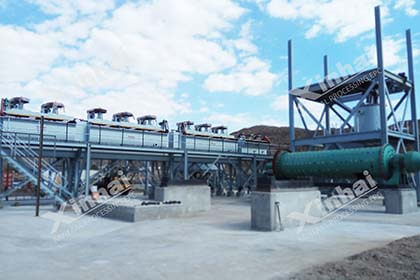A Comprehensive Guide to the Operation of Thickener
 Essow
Essow
 Oct 28, 2023
Oct 28, 2023
 3876
3876
If you want to know more details about equipment, solutions, etc, please click the button below for free consultation, or leave your requirements!
Mining thickener plays a critical role in the efficient operation of mineral processing plants. It is a vital component of the process that separates and concentrates valuable minerals from the ore slurry. This article aims to provide a comprehensive understanding of the operation of mining thickener, highlighting its importance, key components, operational considerations, and maintenance requirements.
01 Thickener Components
BackMining thickener consists of several key components that work together to facilitate the separation and concentration of solid particles from the ore slurry. Here's a closer look at the main components of a mining thickener:
1. Tank or Basin
The tank or basin serves as the main vessel where the settling of solid particles takes place. It is a large, cylindrical or rectangular container that provides sufficient space for the slurry to settle and allows for the separation of clarified liquid.
2. Feedwell
The feedwell is located at the center of the thickener tank and serves as the entry point for the ore slurry. Its primary function is to evenly distribute the incoming slurry across the surface of the thickener, ensuring uniform settling and minimizing turbulence.
3. Rake Arms
Rake arms are mechanical devices equipped with rake blades that rotate slowly inside the thickener tank. The primary role of the rake arms is to move the settled solids, known as the underflow or thickened slurry, towards the center of the tank for discharge.
4. Discharge Cone
Positioned at the center of the thickener tank, the discharge cone collects the underflow from the rake arms and directs it towards the underflow outlet. It helps guide the thickened slurry to ensure a controlled and efficient discharge.
5. Underflow Outlet
The underflow outlet is located at the bottom of the thickener tank and serves as the point of withdrawal for the settled solids. It is designed to allow the controlled removal of the thickened slurry, which contains the concentrated mass of valuable minerals.
6. Overflow Launder
The overflow launder is responsible for collecting and directing the clarified liquid, also known as the supernatant or clarified solution, towards the overflow outlet. It ensures that the liquid phase is effectively separated from the settled solids and can be discharged or further processed.
7. Drive Mechanism
The drive mechanism provides the necessary rotational movement to the rake arms. It typically consists of a motor, gearbox, and associated mechanical components that enable the slow and continuous rotation of the rake arms, facilitating the movement of settled solids.
8. Control System
A control system is essential for monitoring and regulating the operation of the mining thickener. It allows operators to adjust parameters such as rake speed, underflow density, and overflow clarity, ensuring optimal thickener performance and efficient solid-liquid separation.
9. Support Structure
The thickener's support structure provides stability and structural integrity to the entire equipment. It is designed to withstand the weight of the thickener components, the slurry, and any additional loads imposed during operation.

(Thickener components)
02 Working Principles of Thickeners
BackThe operation of a mining thickener involves several fundamental principles:
1. Gravity Settling
Mining thickeners rely on the force of gravity to promote the settling of solid particles within the thickener tank. When the ore slurry enters the tank through the feedwell, the solid particles, heavier than the liquid phase, start to settle under the influence of gravity.
2. Hindered Settling
Hindered settling refers to the phenomenon where the settling of solid particles is impeded due to the presence of other particles or the interaction with the liquid phase. In mining thickeners, hindered settling occurs as particles encounter and interact with each other, creating resistance to settling.
3. Feed Distribution
The feedwell of the thickener is responsible for evenly distributing the incoming slurry across the surface of the thickener tank. This distribution helps prevent localized settling and ensures uniform particle settling throughout the tank.
4. Particle Aggregation
In order to enhance settling efficiency, mining thickeners often employ the use of flocculants or settling aids. These chemicals promote particle aggregation by causing the fine particles to clump together, forming larger and denser flocs. Aggregated particles settle more rapidly due to increased effective size and weight.
5. Rake Mechanism
The rake mechanism, typically equipped with rake arms and blades, is responsible for slowly rotating and moving the settled solids towards the center of the thickener tank. The rake arms continuously sweep the settled particles and direct them towards the discharge cone for removal.
6. Underflow Discharge
The settled solids, also known as the underflow or thickened slurry, collect in the center of the thickener tank and are discharged through the underflow outlet. The controlled withdrawal of the underflow ensures the removal of the concentrated mass of valuable minerals from the thickener.
7. Clarified Liquid Overflow
As the solid particles settle to the bottom, the clarified liquid rises to the top, forming an overflow layer. The clarified liquid, also called the supernatant or clarified solution, is directed towards the overflow launder and discharged from the thickener for further processing or recycling.
8. Control and Optimization
Efficient operation of mining thickeners requires careful control and optimization. Operators adjust parameters such as feed rate, rake speed, flocculant dosage, and underflow density to achieve the desired separation efficiency and maximize mineral recovery. Regular monitoring and adjustment of these parameters are essential for optimal thickener performance.
 '
'
(Thickeners in a gold plant)
03 Optimal Operation and Maintenance
BackOptimal operation and maintenance of mining thickeners are essential to ensure their efficient performance, maximize mineral recovery, and extend equipment lifespan. Here are some key considerations for optimal operation and maintenance:
1. Monitoring and Control
Regular monitoring of key parameters such as slurry feed rate, underflow density, overflow clarity, and rake speed is crucial for optimal thickener operation. Automated control systems or manual adjustments can be employed to maintain desired operating conditions and achieve efficient solid-liquid separation.
2. Feedwell Optimization
The design and operation of the feedwell significantly impact the performance of a mining thickener. Optimizing the feedwell geometry, distribution baffles, and flow patterns can ensure even distribution of the slurry and minimize turbulence, promoting optimal settling conditions.
3. Flocculant Dosage and Mixing
Flocculants are often used to enhance particle aggregation and settling efficiency in thickeners. Proper dosing and mixing of flocculants are critical for achieving optimal performance. Regular monitoring and adjustment of flocculant dosage ensure effective particle flocculation without excessive use, which can lead to operational issues.
4. Rake and Blade Maintenance
The rake arms and blades in a thickener require regular inspection and maintenance. Worn-out or damaged blades can affect the movement of settled solids, leading to uneven distribution and reduced efficiency. Routine inspection, cleaning, and replacement of rake components are necessary to maintain optimal thickener operation.
5. Overflow and Underflow Management
Monitoring the clarity of the overflow and density of the underflow is important for assessing thickener performance. Adjustments in the overflow launder design, froth control devices, or underflow discharge mechanisms may be necessary to optimize the separation efficiency and prevent the loss of valuable minerals.
6. Regular Sludge Removal
Over time, accumulated sludge or sediment at the bottom of the thickener can affect its performance. Regular removal of sludge through manual or automated methods is crucial to prevent build-up, maintain proper tank capacity, and ensure efficient settling of solid particles.
7. Lubrication and Mechanical Maintenance
Proper lubrication of mechanical components, such as the drive mechanism and bearing assemblies, is essential for smooth operation and to prevent equipment failures. Regular inspection, cleaning, and maintenance of mechanical parts ensure optimal performance and extend the lifespan of the thickener.
8. Training and Operator Competence
Providing comprehensive training to operators and ensuring their competence in operating and maintaining thickeners is vital. Operators should understand the thickener's functionality, control systems, and troubleshooting techniques to promptly address any operational issues and optimize performance.
9. Documentation and Record-Keeping
Maintaining accurate documentation of maintenance activities, operational parameters, and performance data is valuable for analyzing trends, identifying potential improvements, and ensuring compliance with regulatory requirements. It also aids in troubleshooting and facilitates historical reference for future maintenance and operational decisions.

(Thickeners)
04Conclusion
BackMining thickeners play a critical role in the mineral processing industry by facilitating the separation and concentration of solids from liquids. Understanding the components and working principles of these thickeners is vital for their efficient operation. By considering factors such as feed distribution, rake design, flocculant addition, underflow discharge, and monitoring, mining companies can optimize the performance of their thickeners, ensuring higher productivity and cost-effectiveness in their operations.
 +86 18716000713
+86 18716000713 xlyin@xinhaimining.net
xlyin@xinhaimining.net




 Message
Message Chat Now
Chat Now


